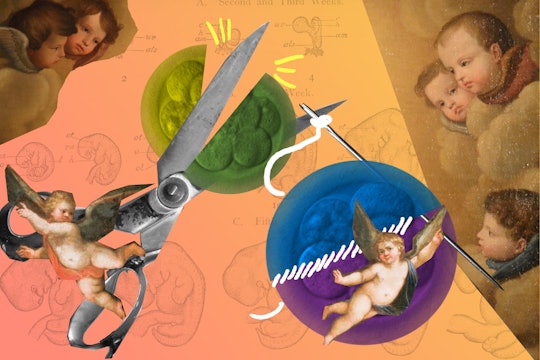
Why 'designer babies' won't be here anytime soon
Human embryos are uniquely resistant to inserting foreign DNA via CRISPR
The study discussed here has become a target of skepticism by others in the field. Many have pointed out that egg and sperm DNA are physically separated in the newly-fertilized zygote, making the templated repair mechanism improbable. Mitalipov has promised a formal response to the criticism, for which we wait with bated breath. - Jay Bassan
If you’re bored at a dinner party, you can always bring up genetically modified organisms and spark a debate as fierce as any about politics or religion. Both sides will have fervent advocates; the doomsayers will warn against tampering with nature, and the ultra-futurists will proclaim the benefits of a world with perfect health. But is either of those opinions based in the evidence accumulated over decades of scientific research?
According to a new study, the truth may lie somewhere in between. Shoukhrat Mitalipov, a scientist at the Oregon Health & Science University, led an international study on genome editing of human embryos and made an unexpected discovery: they were able to remove a crippling genetic mutation that can lead to heart failure, but when they tried to introduce external DNA into the embryos that would fix it, they couldn't. Instead, the embryo itself found a way to fix the damaged gene.
A technique called CRISPR – the latest megastar in molecular biology – makes work like this possible. It harnesses a protein in bacteria called Cas9 to cut out specified parts of a cell's DNA and replace them with new sequences. In less than a decade, CRISPR has already opened countless doors to scientists studying our genetic legacy.
It's opened countless ethical quandaries, too. To look at whether CRISPR could fix a genetic mutation that causes hypertrophic cardiomyopathy, the leading cause of sudden heart failure in healthy athletes, Mitalipov and his team experimented on newly-fertilized human zygotes. The sperm carried the mutation on a gene called MYBPC3, and the eggs were healthy. A person only needs one faulty copy to eventually present with hypertrophic cardiomyopathy – that relative simplicity is what made Mitalipov want to try fixing it.
This is dicey ethical terrain indeed: the cells that Mitalipov used could, upon implantation to a suitable surrogate, have developed into human beings. The US National Institutes of Health does not currently allow public money to be spent on embryonic research like this, but it will grant a permit if the project is deemed suitable and the funds are privately secured. The donors were fully informed of what was to be done with their samples, and the team had to destroy the embryos five days after fertilization.
They plowed ahead, employing CRISPR to try and fix the MYBPC3 mutation. It was at this point that the team made its most radical discovery. Normally, an external piece of DNA provides the template for replacing the gene that is cut out. This is the basis for public concern surrounding CRISPR, the idea that we could edit embryos to replace an undesirable trait with an arbitrary, designer characteristic.
But Mitalipov and his team found that, no matter what external DNA template they added to the cells, the embryos preferred to use the healthy gene from the egg to repair the sperm’s faulty code. Other research previously suggested that cells in the embryo employ different DNA repair mechanisms than normal cells, but this is the first time scientists have documented it in viable human embryos. They tried to artificially modify the genome of fertilized embryos but ended up proving that they use an alternate mechanism of DNA repair than mature human cells do, one that makes an embryo a hostile environment to a DNA interloper. Mitalipov speculates in his paper that this extra protection probably comes from the need for perfect embryo development: if even one gene is damaged upon fertilization, the fetus may not be viable.
This finding is more than a potential source of relief for designer baby doomsayers. It's also the apex of years of diligent gruntwork in the lab. Mitalipov and his team have dedicated years of their lives to understanding the molecular mechanisms involved in human reproduction. In 2009, they bred rhesus macaques using genetic material from three adult monkeys to advance the treatment of certain heritable mitochondrial diseases. Four years later, they published a paper describing a new method of generating human stem cells from skin.
The latest study pushes further, telling the doomsayers that the very research they oppose may actually assuage their fears while reminding the CRISPR enthusiasts of the resilience of nature to human intervention. It is, for me, evidence that we should continue funding science for the sake of understanding nature, and that we should endeavor to base our opinions on evidence rather than premature speculation.
